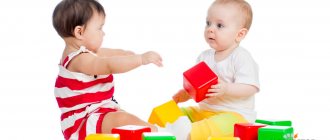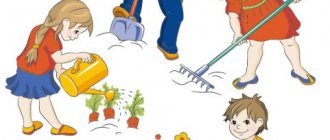Article “Labor education of young children”
In early age groups, children's work is organized in the form of individual assignments. Kids are little interested in the result; they are attracted by the process of action itself. And so they work together with the teacher: they help set the table, lay out materials for classes, water the plants, pick vegetables in the garden, etc. The adult takes on the most difficult work, leaving for the child what he can do. In the process of work, the teacher helps the child master the necessary skills, cope with emerging difficulties, and correct mistakes.
The purpose of labor education:
Contribute to the formation of a positive attitude towards work.
Types of work for young children:
Self-service
- this is the work of a child aimed at serving himself (dressing, undressing, eating, sanitary and hygienic procedures).
Household work
has a social orientation. This is the work of maintaining order in a room or area.
Labor in nature
– this is the work of caring for plants and animals, growing vegetables in the garden, landscaping the area, etc.
SELF-CARE.
1. To promote in children the ability to independently care for themselves (while undressing, dressing, washing, eating).
2. Encourage children, under the supervision of an adult, and then wash their hands independently when dirty and before eating, wipe their face and hands dry with a personal towel.
3. Contribute to the development of the ability to put oneself in order with the help of an adult.
4. To promote the development of the skill of using individual objects (handkerchief, napkin, towel, comb, pot).
5. Encourage children to be independent when eating, teach them to hold a spoon in their right hand.
6. Ensure the development of the ability to dress and undress in order.
7. Encourage the child to take off clothes and shoes (unfasten front buttons, Velcro fasteners) with a little help from an adult.
8. Ensure the development of the ability to carefully fold removed clothes in a certain order.
9. Encourage people to wear clothes and shoes correctly.
HOUSEHOLD WORK.
1. Contribute to the development of the ability to put toys and things in their place.
2. To promote the habit of maintaining cleanliness and order in the group.
3. To promote the development of the ability to correctly carry a chair and place it in the right place.
4. Provide familiarization with the work of adults (nanny, janitor, driver, nurse, cook).
5. Encourage you to carry out the teacher’s instructions, help adults: put garbage in the basket, lay out boards for modeling, arrange bread bins without bread, napkin holders, lay out spoons, etc.
WORK IN NATURE.
1. Involve children in watering flowers in the flowerbed under the guidance of a teacher.
2. Promote the desire to care for indoor plants.
3. Encourage feeding birds in winter.
4. Ensure the development of the ability to work with shovels, brooms, and rakes.
5. Create a desire to help the teacher plant onions,
in sowing large seeds (peas, beans, nasturtium), etc.
Emphasizing the role of labor education, K. D. Ushinsky wrote:
“The opportunity to work and love for it is the best inheritance that both the poor and the rich can leave to their children.” Labor education should be part of a child’s life from a very early age and carried out consistently and systematically.
MAGAZINE Preschooler.RF
Formation of initial labor skills in young childrenBalabanova Maria Gennadievna, teacher of the 1st qualification category of the municipal autonomous preschool educational institution "Kindergarten No. 24 of a combined type"
Self-care is the beginning of the labor education of a preschooler. The formation of self-care skills is of paramount importance for the mental development of the child as a whole. Mastering self-care skills (the ability to dress and undress, take care of yourself, use the toilet, eat independently, wash yourself, etc.) directly affects the child’s self-esteem and is an important step towards his independence.
Recently, more and more parents are overprotective of their children. Some parents often do everything for their children (clothing, feeding), believing that their child is still very small. This leads to the child not developing independence in self-care skills.
The initial prerequisites for the development of labor activity and labor education of children are laid at an early age.
Let's figure out where to start and how everything should happen to achieve the desired result. First, let’s answer the question: for young children include For a child of the third year of life, self-care includes mastering the following skills:
- eating (eating with a spoon, drinking from a cup)
- undressing and dressing (taking off and putting on shoes, panties, tights, shorts, trousers or skirt, hat, mittens)
- body hygiene (wash hands and face, dry them with a towel, use a handkerchief and napkin)
- neatness (use the potty).
At the same time, children begin to be involved in performing simple labor actions with similar results: bring some objects, put a plate of bread on the table, collect cubes from the floor into a box, etc.
Elementary labor actions present significant difficulties for children, and their development requires careful pedagogical guidance. We develop self-service skills based on the great interest of children of this age in independent actions with objects, and on greater imitation of the actions of an adult. all attempts to independently achieve results ( “I do it myself!” ). However, in order for a child to achieve a result, the baby must be taught to see it and taught the appropriate actions. This is done by adults both during self-service and in the process of household work, where the child is only a spectator, for example: they washed their hands - they became clean; wiped with a towel - they became dry and clean; We ironed the dolls' dresses - they became beautiful, ironed. The emotional reaction of an adult to achieving a result forms an emotionally positive attitude towards him and the child, awakens the desire to achieve it. An explanation from an adult once again allows you to connect the process of action with the result and goal: you washed your hands, they became clean - you can go to lunch.
As work actions are mastered, the teacher helps only with the most difficult ones for the child, and then simply prompts the next action that the child performs (first straighten the towel on your hands, then wipe your face, etc.). Every child's success must be celebrated. Encouragement creates a joyful mood in the child, a desire to repeat the action, to achieve the desired result.
To consolidate the initial labor actions, the following conditions are necessary:
a) demonstration, explanation and exercise;
b) consistency of requirements for children in kindergarten and in the family (children themselves perform feasible self-care activities);
c) constancy of requirements for the sequence of execution, quality of work actions and results;
d) a calm business environment that takes into account the child’s capabilities;
e) transition from individual learning to group learning as the actions are mastered and the ability to listen to an adult.
The independence of a child of this age in self-care is based on the development of the skills of buttoning, unfastening, lacing, etc. To develop such skills, play exercises are used (dressing dolls, when children repeatedly button or unfasten their clothes) and specially made teaching aids - different types of fasteners. Children willingly practice quite complex movements and master the necessary skills. I take a creative approach to using folklore as an emotional and figurative means of influencing children. This causes children joy, pleasure, and a desire to learn skills on their own.
In order to consolidate the sequence of labor actions for self-care (dressing, undressing, washing, etc.), organized educational activities are carried out using game techniques: put the doll to sleep, dress the doll for a walk, wash the doll, etc.
All this ensures not only learning, but also habituation, that is, nurturing the habit of acting in certain conditions in a learned way. A small child develops habits quickly and quickly fades away. Therefore, it is necessary to constantly repeat labor actions, taking into account the capabilities of the growing child. Thus, the methodology of labor education provides for the formation of labor actions in young children, their focus on results and the desire to overcome feasible difficulties in the process of achieving results.
Any action can be divided into small subactions performed in a certain order. When teaching your child a new skill, create an algorithm and act according to it each time. An example of putting on panties might look like this:
Sit on the chair
Take the waistband of your pants with both hands
Lift one leg and put it in one pant leg
Put your foot on the floor
Lift the other leg and put it in the other pant leg
Stand up and pull your pants up with both hands
For each subaction, you can draw schematic mnemonic tables that can be shown to the baby while performing the action to make it easier to remember the sequence of its implementation.
Remember that the speed of formation of self-care skills depends on the individual characteristics of the child, the type of nervous system (choleric, phlegmatic, sanguine and melancholic), on the speed of memorization, on the family attitude towards cleanliness and tidiness, since it is the example of parents and loved ones that is the main thing for the baby.
Don’t forget to give a positive assessment to your child’s actions! Any praise has a positive effect on achieving a good result. This could be a kind word or touch, small homemade gifts (made of paper, thread, salt dough or plasticine, crafts made from natural materials), and sometimes a sweet treat. Use different ways to tell your child that he is doing well: “Very good! Well done! Great! You did it! Hooray! Amazing! You did it! Great! Right! I am so glad!"
| Next > |
Mastering new types and forms of labor.
The following types of work for preschoolers are distinguished:
1. Self-care work (starts at an early age). First, it is directed at oneself (combed one’s hair, washed one’s hands), then at another, which is a prerequisite for the development of everyday work.
2. Household work. The object of transformation are objects included in the everyday process (dishes, clothes, shoes). External attributes play an important role: an apron, vacuum cleaner, broom, brush, etc. (very attractive to children). The result will be interesting if an adult forms the need to maintain order, work is organized aesthetically attractive, constantly pointing out the possibility and significance of such work for other people to form social motives.
The main areas of household work are: organizing one’s own household activities (cleaning clothes so that they don’t spoil; it’s nice when you look neat; arranging cutlery beautifully - it’s nice to dine), as well as facilitating the work of another person (helping mom wash clothes so that she can do less tired).
3. Labor in nature. The objects here will be plants and animals (weaker than the child himself, so their well-being depends on the child to a certain extent: forgot to water a flower - it dried up; did not give water to the puppy - it suffers from thirst). Thus, the child develops responsibility for those who are more defenseless than the child (the child feels big, mature, strong, experiences bright positive emotions, feels involved in nature).
4. Manual labor - requires complex actions (ability to use a needle, skein, etc.). A child masters this type of work from about 5 years old. Originality - labor acquires its own productive character. The child creates an idea, implements it and receives a new product (embroidery, crafts). The main motives for manual labor in preschool age can be the following: playful (attributes for playing), social (to please the kids, to please mother), aesthetic (to create something beautiful, to decorate your home). As a result, the position of a creator develops.
Thus, in mastering different types of work there are two interrelated trends: the child’s independence increases within the limits of the skills he has developed and the child gradually becomes involved in life together with adults, performing ordinary everyday duties with them.
The forms of organization of children depend not so much on age, but on the level of development of children’s labor skills and the content of work tasks.
forms of organizing the work activity of a preschooler are distinguished :
1. Joint work with adults (most common in early and early preschool age). An adult teaches labor skills, controls the labor process, shows the sequence of actions, helps to achieve results and understand methods of action, their connection with the result obtained.
2. Order. An adult formulates a goal, substantiates its significance, highlights the end result, and ways to achieve the goal. A child can carry out an assignment if the work actions are familiar to him.
3. Responsibility arises if the child understands the need to constantly systematically perform any task. The content is determined by the adult, then the child himself chooses the conditions, means and ways to achieve the result, organizes and controls the labor process. This is possible only in constantly repeating work processes and in familiar conditions.
4. Work on one’s own initiative – as a manifestation of the highest level of independence. The child not only organizes the work himself, but notices when it is necessary to work.
Labor as a means of comprehensive development of children of primary preschool age
Work as a means of comprehensive development of younger preschoolers
“Only with good organization does a child experience the joy of work” A. S. Makarenko Preschool age is the most important stage in personal development. The harmonious development of a child is the basis for the formation of a future personality. It depends on the successful solution of many educational tasks, among which issues of labor education occupy a special place. Labor education is a necessary and essential condition for the successful preparation of children for school. Children raised to work from an early age are distinguished in school by their independence, organization, activity, neatness, and ability to take care of themselves. Labor education of younger preschoolers has its own specifics. Its main task is to create the prerequisites for a positive attitude towards the labor process. To successfully solve the problems of labor education of preschool children, the creation of the necessary conditions is of primary importance. The work of preschool children is closely related to play. This relationship manifests itself in different forms: play reflects the work of adults; elements of labor actions are reflected in the game; labor activity is carried out for the sake of future play; play actions are included in the labor process. By reflecting the labor actions of adults in games, children become imbued with a positive attitude towards their work; They show attention to passengers, make sure that lunch is tasty, and the like. During the training of labor skills, it is necessary to form in children the desire to do independently everything that they can, coming to the rescue whenever they need it. It is unacceptable for preschoolers to feel upset from unsuccessful attempts to independently cope with the proposed task, since in these cases, self-doubt and reluctance to work are born. On the contrary, encouraging any attempt by a child to show independence helps him overcome difficulties. Preschool level education allows you to integrate labor education with almost any type of activity. So, in classes to familiarize younger preschoolers with work, children are told what a hardworking person should be (he works diligently, gets the job done), what it means to work well, and how to care about others. When working with children, it is necessary to use illustrations, paintings, fiction, small folklore forms, as well as play techniques. For example, singing the Swedish song “excellent wheat” or the Czech song “Help” and others like them makes children want to help others. The Russian folk tale “Turnip” and N. Pavlova’s story “By the Car” tell stories of friendship and mutual assistance in an entertaining way for kids. The Russian folk tale “The Cockerel and the Bean Seed” is interesting for conversation with children. In joint activities with children, use play techniques that increase the activity of children, promote imitation and develop their interest in work. For example, remind: “A mouse is now watching our work. She really wants you guys to learn how to neatly put clothes in your locker”... The work of children in kindergarten is varied. This allows them to maintain their interest in activities and provide them with a comprehensive education. In work, children master a variety of skills and abilities necessary in everyday life: in self-service, in household activities, etc. Self-care is aimed at personal care (washing, ability to undress and dress, cleaning and preparing the workplace). The educational significance of this type of work activity lies, first of all, in its vital necessity. The poems of Z. Alexandrova “My Teddy Bear”, E. Blaginina “Don’t Disturb Me from Working”, Y. Tuvim’s “Letter”, A. and P. Barto “Greasy Girl”, K. Chukovsky’s “Moidodyr” help to form the initial ideas of younger preschoolers about self-service. " Due to the daily repetition of actions, self-service skills are firmly acquired by children; self-care begins to be recognized as a responsibility. When guiding children’s self-care, try to maintain their positive emotional state, communicate individually with each child, and establish various contacts with them. By naming items of clothing and necessary actions during self-service, you expand children's vocabulary. Do you think work can become an important part of the mental development of children? Undoubtedly. This is another area that can be most fully combined with labor education. For example, in ecology classes, children practically learn the properties of the world around them, observe the growth of plants and changes in plants, examine animals, getting acquainted with their living conditions, etc. They develop curiosity and educational interests. When guiding the work of children, in nature it is necessary to name plants, their parts, actions performed in work; this further expands the children's vocabulary and activates it. When looking at plants with children, offer to examine the object in different ways: “Show where the leaves are small and where they are large,” “Smell the flower,” and so on. Explain the need to care for plants and animals daily. Aesthetic education is also carried out in work activities. In order to develop children's aesthetic taste, you can use, for example, such didactic games as “What never happens in the world,” “Wonderful gnomes,” “Count how many flowers have bloomed,” and any others. It will be useful to create a card index of such didactic games aimed at both labor education and artistic and aesthetic development. Through didactic games, children develop the ability to do any task carefully. They rejoice when they notice a new bud when watering plants, inspecting the neatly arranged toys and cleanly washed doll clothes. Another area integrated with labor education is seasonal observations in nature. The observation process includes artistic expression, outdoor games, work assignments for children, and observation of the work of adults. Using the example of observing the cleaning of the walking area of a kindergarten, you can easily introduce pupils to how a janitor cleans the area and what equipment he uses. In addition, work strengthens children physically, since they perform most of the tasks outdoors (bring water, water plants, rake leaves and other seasonal work). Children become capable of exerting their strength and overcoming difficulties. of particular importance for the formation of moral qualities; in the process of labor activity, children develop basic household skills: helping to set the table, tidying up toys after playing and washing them, collecting leaves on the site, sweeping snow from benches, etc. d. It is necessary to evaluate the moral side of children's labor participation. Such assessments make children want to imitate their peers and contribute to the formation of ideas about how to act in such cases. In addition, it is important to formulate in preschoolers ideas about the importance of the work they are doing for the team, to cultivate a desire to complete their work on time, and to show concern for others. By addressing those on duty as their assistants and thanking them for the timely completion of their duties, the teacher teaches all children to respect the work of their peers. By developing in children the ability to show effort, be careful, and complete tasks to the end, it is important to instill in them a positive attitude towards any work. Labor education of children is carried out successfully only if the kindergarten and the family work together. At parent meetings and individual conversations, talk about the program’s requirements for the labor education of children of primary preschool age. Offer parents specific recommendations about the content of children’s work at home, about methods and forms of organization and leadership. For example: before demanding high-quality work from a child, you should show and explain what he should do and how; do not punish with work, reward for efforts, do not overload. Work becomes a means of education when it is systematic. Each child must often carry out various tasks, be on duty, and take part in collective work. When raising a child in work, remember that the child’s abilities develop mainly in the conditions of activity.
We recommend watching:
Summary of educational activities on labor education for children of the middle group Creating a developing subject-spatial environment for preschoolers at home
Similar articles:
Training children of the younger group in labor activities
Formation of hard work in preschool children








